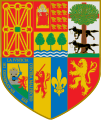Wêne:Zazpiak Bat.svg

Size of this PNG preview of this SVG file: 504 × 600 pîksel. Resolusyonên din: 202 × 240 pîksel | 403 × 480 pîksel | 645 × 768 pîksel | 860 × 1024 pîksel | 1721 × 2048 pîksel | 579 × 689 pîksel.
Dosyeya orjînal (Daneya SVG, mezinbûna rast: 579 × 689 pixel; mezinbûna daneyê: 1,38 MB)
Dîroka daneyê
Ji bo dîtina guhartoya wê demê bişkoka dîrokê bitikîne.
| Dîrok/Katjimêr | Wêneyê biçûk | Mezinahî | Bikarhêner | Şirove | |
|---|---|---|---|---|---|
| niha | 20:42, 30 nîsan 2009 |  | 579 x 689 (1,38 MB) | SanchoPanzaXXI~commonswiki | retoque lobos |
| 18:31, 30 nîsan 2009 |  | 579 x 689 (1,39 MB) | SanchoPanzaXXI~commonswiki | rediseño | |
| 19:52, 28 çiriya paşîn 2007 |  | 550 x 650 (384 KB) | SanchoPanzaXXI~commonswiki | {{Information |Description={{en}}Modern version of en:Zazpiak Bat insignia. From the Basque words zazpiak meaning "the seven ones" and bat meaning "one", translates as "the seven ones [are] one", refers to the seven historical Basque Country territor |
Bikaranîna pelê
Ev rûpelên li jêr vê dosyeyê bi kar tînin:
Bikaranîna gerdûnî ya pelê
Ev wîkiyên di rêzê de vê pelê bi kar tînin:
- Bikaranîna di ar.wikipedia.org de
- Bikaranîna di bs.wikipedia.org de
- Bikaranîna di ca.wikipedia.org de
- Bikaranîna di da.wikipedia.org de
- Bikaranîna di en.wikipedia.org de
- Bikaranîna di en.wikiversity.org de
- Bikaranîna di eo.wikipedia.org de
- Bikaranîna di es.wikipedia.org de
- Euskal Herria
- Escudo de Navarra
- Usuario:Keat
- Usuario:Ultrasiete
- Usuario Discusión:Martiko
- Wikiproyecto:Euskal Herria
- Wikiproyecto Discusión:Euskal Herria
- Wikiproyecto:Euskal Herria/Userbox2
- Usuario:Tximist
- Usuario:Ignaciojd3
- Usuario:Zarateman
- Usuario:Janfri
- Zazpiak Bat
- Usuario:Rikku~eswiki
- Usuario Discusión:Tximist
- Wikiproyecto Discusión:Euskal Herria/Discusiones2
- Portal:Navarra/Portales Relacionados
- Portal:País Vasco
- Portal:País Vasco/Portales relacionados
- Inmigración vasca en Chile
- Usuario:Marine13
- Usuario:El-Numero
- Xabi Aburruzaga
- Usuario:Pablitop
- Usuario:Aberzale
- Usuario:Igalix/Archivo de 2007-2010
- Usuario:Userbox/Localización/España
- Usuaria:Userbox mujer/Localización/España
- Koruko Ama Birjinaren Eskola
- Usuario:Raulsalvatierra1998
- Usuario:Sejuzu
- Jean de Jaurgain
- Armorial de las familias vascas
- Usuario:Gogoter
- Bikaranîna di eu.wikipedia.org de
Zêdetir bikaranîna global a vê pelê bibîne.
